The question of whether or not one can eat a horseshoe crab is a controversial and polarizing topic amongst many people. While some claim that they do not have the taste for it, others say that they absolutely love horseshoe crab. It’s also important to note that there are different species of these crustaceans depending on where you live in the world.
The most common type found in North America is Limulus polyphemus (hence why we call them “horseshoes”), which has long been a delicacy throughout the US and Canada. In Asia, another species called Carcinus maenas (which we know as the Asian clam) is more popular. Both are very similar but do vary slightly from each other with regard to size and appearance.
In this article, I will answer all your questions about horseshoe crabs, including what exactly they are, if you can eat them, how they taste, and even give you a simple horseshoe crab recipe. So without further ado, let’s begin!
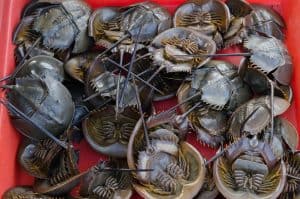
About horseshoe crab
Horseshoe crabs can be seen roaming the ocean floor by their large claws, which resemble a half-open pair of pincers. They use those claws to catch food, push themselves through the sand, and dig burrows into the seafloor. This behavior makes them very unique among other types of sea life.
They typically grow up to around 19 inches (48cm), although larger varieties exist. Their average weight is approximately 5 pounds (2.3 kg). These animals have soft shells made of calcium carbonate and chitin and no hard exoskeleton. Unlike lobsters, horseshoe crabs don’t walk backwards when they’re disturbed. Instead, they retreat back under their protective shell cover. And unlike tarantulas, they don’t shoot silk out of their fangs.
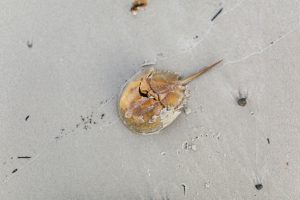
Can you eat horseshoe crab?
Yes, you can. However, before eating any seafood, you should always check its safety first. If possible, ask the restaurant staff or fishmonger at the store you plan to purchase the item from for information regarding the specific species of fish or shellfish you intend to order.
You may find that certain types are off limits due to high mercury levels — and while you might think that since it’s an invertebrate animal, it wouldn’t contain much of the toxic element, this isn’t necessarily true. For example, lobster contains high amounts of dioxins, which are known carcinogens.
If you decide to go ahead with ordering a horseshoe crab, make sure you get yourself some roe or a meaty part. Roe is safe to consume because does not have any bones, so no chance of getting them stuck inside of you. Also, when purchasing the meat, look closely at where they were caught. Make sure the waters were free of pollution.
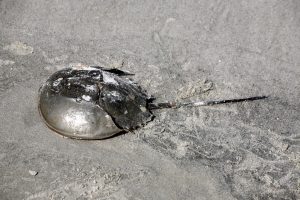
Can you eat horseshoe crab eggs?
Eggs are actually considered to be part of the adult horseshoe crab itself. When eaten raw, they provide a pleasant crunchy texture that resembles oyster crackers. But if you want to try cooking them, you’ll need to boil them first. After boiling for several minutes, you can peel away the outer membrane and enjoy the white flesh within.
Is horseshoe crab poisonous?
While it is true that the species of Limulus polyphemus used for human consumption has caused several poisonings over the years, there are plenty of horseshoe crabs who pose absolutely no threat to humans. As mentioned earlier, the two main species in use today are the Limulus polyphemus and the Carcinus maenas.
For the latter, however, only the roe is edible. The rest of the body must be discarded. The roe is often referred to as “tomalis,” or “turtle eggs.” Eating too many of these can result in severe stomach pain, diarrhea, and vomiting. Despite being extremely bad tasting, the roe is said to be quite delicious.
It is best to avoid C. maenas altogether, especially if you suffer from allergies to seafood. Aside from having a slimy texture similar to mucous, the carapaces of both male and female specimens are covered in barnacles, which can irritate the skin and cause rashes.
Although the American Horseshoe Crab Association states that no deaths have ever occurred as a direct result of consuming Limulus polyphemus, there have been numerous reports of poisonings related to this particular species’ consumption elsewhere. Cases such as these lead some to believe that unless you specifically request a specimen whose claw doesn’t contain the venom glands, you shouldn’t consume the entire creature yourself.
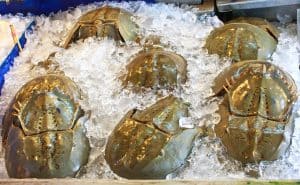
Do horseshoe crabs taste like crab?
Due to the fact that horseshoe crabs lack the ability to swim, they cannot move towards their prey to attack them. Therefore, they feed primarily upon planktonic organisms and small crustaceans. Because of this, their flavor is similar to that of shrimp rather than crabmeat.
Horseshoe crab recipe
Here is a quick and easy horseshoe crab recipe you can whip up. Start by peeling away the tough outer covering of the shell using a paring knife. Next, clean the meat thoroughly with hot water. Then take a piece of the meat and grind it down until fine.
Place the fine bits into a bowl along with 1 teaspoon of salt, 2 teaspoons of lemon juice, and 3 tablespoons of olive oil. With a fork, mix everything together well. Finally, serve immediately and garnish with fresh parsley. Enjoy!
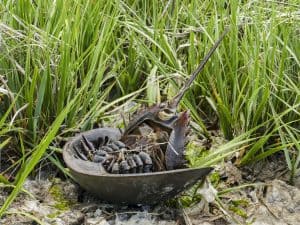
Conclusion
As you’ve learned above, you can eat horseshoe crabs. Whether you choose to cook them yourself or order them at restaurants, you can definitely enjoy this tasty crustacean.
Just remember to stay vigilant when doing so and pay close attention to the area in which they were caught. If possible, ask about the origin of the meat you are buying, as different areas produce different kinds of food. And if you are allergic to seafood, steer clear of horseshoe crabs completely.
Finally, check out or related articles on edible seafood: Blobfish, Bowfin, Cobia, Ladyfish, Snakehead and Tarpon.